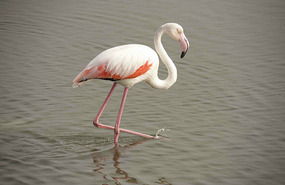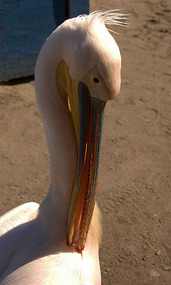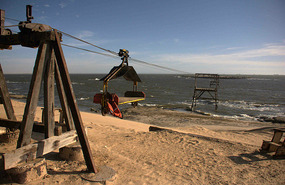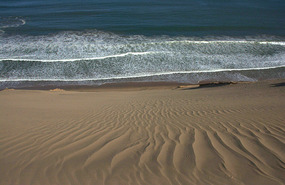It was a long and somewhat featureless drive from Etosha to Swakopmund on the Namibian Coast. Mile after mile of bush scrubland past us and we only managed one brief stop on the way for a coffee. Luckily for us this was all tarmac. We were fortunate that the anticipated six hour drive was actually only close to four. This was not a consequence of the travelling speed, but rather that the person I had asked probably just guessed the travel time rather than admit to having never driven that particular route.
Eventually after some three hours of dry, sandy bush scrub land we started the gradual descent into Swakopmund through the Namib Desert
. This was as barren as barren could be and the journey was only broken by the existence of the odd mine we just happened to pass. Swakopmund and its neighbouring town of Walvis Bay are famous throughout the world for the Namibian Desert. Here huge towering sand dunes reach right to the waves in the south around Walvis Bay in the north of Swakopmund the region is dominated by the deserted and dry wastelands of the Skeleton Coast. This was an area that both myself and my father had wanted to visit for many years, but for very different reasons.
Swakopmund is Namibia’s main beach resort with a sea temperature of well under 15C (go figure the beach resort status). It has an eclectic mix of German and Namibians. The guidebook was interesting saying “it can be an eerie feeling entering Swakopmund as it feels like a surreal colonial remnant. Some find it soothing, others find it weird.” I found it just plain weird. Walvis Bay, some 30 Kms south, is the original British port and has a sweeping bay with thousands of wading birds including one of the largest flocks of Greater and Lesser Flamingos in Southern Africa
. After missing out with the flamingos in Kimberly, I was keen to stay there.
Many people visit here for the adventure sports that the area has to offer on both the water and on the dunes. I was interested in the desert. Dad was keen to visit because of something he had been told several years ago. He denied that he was expecting an African version of St Tropez, but his disappointment was palpable as we entered the “weird” city.
From a temperature in the mid thirties, we arrived in Swakopmund to be greeted by 14C and fog. This apparently is somewhat normal and this was only to get worse as we moved south towards Walvis Bay. “We get a lot of fog here,” our B&B man informed us, “at least 300 days a year!” But Dad appeared to be more upset by the landscaping. “Nothing green here,” I heard him mutter. Indeed it was like Palm Springs with the Palms - or the Springs for that matter. Just row after row of concrete box houses. The majority with no garden. Sand and concrete boxes everywhere. Certainly no St Tropez.
After a good monkfish meal in the centre of Swakopmund we headed off to Walvis Bay. En route it just got worse, colder and even less green. Between the two towns were several new developments and plots where condos were being constructed
. There was no green anywhere, just sand and sea with out a beach. Many of the finished concrete blocks were empty and the streets completely featureless, like some American Western Ghost town, just with no cactus, cowboys or anything. The wind just howled. It blew sand over the road and the occasional fake palm tree (hiding a mobile phone mast) tried to sway. Dad reckoned he was coming close to Hades.
We checked into a B&B in Walvis Bay run by a Dutch man and his wife from Croydon. They were very friendly and welcoming and they did have some green plants. It was cold and damp outside and no time for camping, so had we had long decided on the B&B option and he recommended a local restaurant on the bay called the Anchor. After a cold windy walk along the bay we enjoyed one of the best seafood meals I have eaten. The calamari was literally the best, beating anything I have had in the Mediterranean. The swordfish was equally fine and for the next few days we hardly visited anywhere else
.
The next morning after a cold night (no heating anywhere) we started exploring the area in the sunlight (unaware this was the last we would see of that). The flamingos were impressive and stretched right along the bay right up until the large salt works. Photographing these and the odd Giant Pelican was great, but many other birds had not arrived as it was the winter. We also tried to find the other birding areas mentioned in the Lonely Planet, but true to form the sewage works was closed (the first one recommended) and Pelican Point (the second) was only accessible by 4x4.
It was then that we tried to locate Guano Island where the Lonely Planet said you could see Oyster Catchers. This seemed somewhat strange as I understood Guano Island was where people harvested Guano. Dad (I was unaware at the time) did not know that Guano is another word for shit and became very animated about finding this island
. This ignorance (with the benefit of hindsight) went a long way to explaining his incredulous reaction to the lack of sign posts and the fact that no one seemed to know much about it. When I said “we probably cannot visit the island”, he would have none of it.
We eventually did track it down between two new condo developments (ghost towns). It was a large man made platform about 200m off the coast accessible by a sort of ski lift with no safety bars on the chairs. Just about the wind swept seas I could just make out some birds on the platform. Workers (maybe from Angola) were there and spoke little English but confirmed they were there to collect the Guano. Seeing Dad’s face when he understood what they were collecting shit, commercially was… priceless. He then saw that access was not only futile but dangerous. I felt sorry for the workers.
Back at the B&B he seemed disconsolate. His vision of the St Tropez of Africa was in ruins and he was not the same afterwards, and he started to feel unwell. The temperature (both inside and outside) probably did not help as there was no heating anywhere and it was now very cold and very foggy.
The next day he did not feel well enough to come to Sandwich Harbour on a 4x4 tour, so I went alone. Sandwich Harbour was the first British enclave on the Namibian coast and the dunes had long since reclaimed it. But as it was now only accessible by 4x4 tour it offered the remarkable view of towering Dunes meeting the waves. It was certainly spectacular and it was memorable seeing Springbok and Jackals running over these vast dunes. The trip also involved some 4x4 dune driving which is surely the preserve of petrol heads (plus that Clarkson bloke) and is responsible for devastating dune and environmental damage both here and in Sossusvlei. Nevertheless the views were spectacular and the animals interesting, especially a close encounter with a Puff Adder.
Back at Walvis Bay, Dad was feeling worse but resisting attempts to take him to a doctor. I made myself busy with car cleaning and let the B&B owner try and talk him into medical attention. Eventually he decided that he felt too ill and after we cancelled the planned trip to the Skelton Bay, he booked a flight back to Cape Town. We were almost at the end of the trip really so the only thing he was going to miss was Sossusvlei, so it was probably for the best. We did get him to the local doctor who could understand what was wrong either, so the following day, I put him on the plane.
Throughout all of this the B&B was excellent and very understanding. The Anchor certainly provided some excellent fresh fish dinners whilst Dad was not well and it was a shame Dad’s trip had to end this way. “Its this place that has made me ill,” he said as he left.
I packed up the car and left for Sossusvlei as the Safari trip to the Skeleton Coast would not take me on my own.
Fog, concrete, sand, cold, wind plus illness
Thursday, July 17, 2014
 Walvis Bay, Namibia
Walvis Bay, Namibia
Other Entries
-
47Baguettes, Renault 4s and a little bit of France
Apr 0999 days prior Antananarivo, Madagascarphoto_camera2videocam 0comment 0
Antananarivo, Madagascarphoto_camera2videocam 0comment 0 -
48Indri, Chameleons, Weevils, Frogs and Night Safari
Apr 1296 days prior Andasibe, Madagascarphoto_camera6videocam 0comment 0
Andasibe, Madagascarphoto_camera6videocam 0comment 0 -
49Air Mad, Rain, Leeches, Trekking, Jungles
Apr 1890 days prior Sambava, Madagascarphoto_camera6videocam 0comment 0
Sambava, Madagascarphoto_camera6videocam 0comment 0 -
50Sifakas, Pygmy Kingfishers, Maroujejy NP Part 2
Apr 2187 days prior Manantenina, Madagascarphoto_camera6videocam 0comment 0
Manantenina, Madagascarphoto_camera6videocam 0comment 0 -
51Cream sauces, paradise, sandy beaches, wildlife
Apr 2781 days prior Diego Suarez, Madagascarphoto_camera5videocam 0comment 0
Diego Suarez, Madagascarphoto_camera5videocam 0comment 0 -
52Tsingy Rouge, Lemurs, Corruption, Air Madagascar
May 0177 days prior Joffreville, Madagascarphoto_camera5videocam 0comment 0
Joffreville, Madagascarphoto_camera5videocam 0comment 0 -
53Glamping, Nat Parks, Dew, Blood & Gooners
May 2256 days prior Swellendam, South Africaphoto_camera5videocam 0comment 0
Swellendam, South Africaphoto_camera5videocam 0comment 0 -
54Big Holes, Shut Attractions, Bush, Endless Roads
May 3048 days prior Kimberley, South Africaphoto_camera4videocam 0comment 0
Kimberley, South Africaphoto_camera4videocam 0comment 0 -
55Fires, Towing and the Kindness of Strangers
Jun 0146 days prior Gaborone, Botswanaphoto_camera1videocam 0comment 0
Gaborone, Botswanaphoto_camera1videocam 0comment 0 -
56Auto Parts, Nata Birds, Wind and Elephants
Jun 0641 days prior Francistown, Botswanaphoto_camera3videocam 0comment 0
Francistown, Botswanaphoto_camera3videocam 0comment 0 -
57Water, Rivers, Camping, Customs and Getting Wet
Jun 1037 days prior Victoria Falls, Zimbabwephoto_camera5videocam 0comment 0
Victoria Falls, Zimbabwephoto_camera5videocam 0comment 0 -
58Sand, Hides, Elephants, Birding, getting Stuck
Jun 1532 days prior Kasane, Botswanaphoto_camera7videocam 0comment 0
Kasane, Botswanaphoto_camera7videocam 0comment 0 -
59Safari, Glamping, Sand & Wildlife
Jun 2027 days prior Savuti National Park, Botswanaphoto_camera4videocam 0comment 0
Savuti National Park, Botswanaphoto_camera4videocam 0comment 0 -
60Charging Hippos, Delta, Glamping & Roaring Lions
Jun 2522 days prior Maun, Botswanaphoto_camera4videocam 0comment 0
Maun, Botswanaphoto_camera4videocam 0comment 0 -
61Creationists, Rare Birds, Rock Art & Meteorites
Jun 2819 days prior Rundu, Namibiaphoto_camera5videocam 0comment 0
Rundu, Namibiaphoto_camera5videocam 0comment 0 -
62Bushmen, Hunts, the San, Gravel Roads, Car Trouble
Jul 0413 days prior Tsumkwe, Namibiaphoto_camera8videocam 0comment 0
Tsumkwe, Namibiaphoto_camera8videocam 0comment 0 -
63Animals, waterholes, dust, more dust
Jul 107 days prior Etosha National Park, Namibiaphoto_camera4videocam 0comment 0
Etosha National Park, Namibiaphoto_camera4videocam 0comment 0 -
64Fog, concrete, sand, cold, wind plus illness
Jul 17 Walvis Bay, Namibiaphoto_camera5videocam 0comment 0
Walvis Bay, Namibiaphoto_camera5videocam 0comment 0 -
65Red Dunes, Mud Flats, Quiver Trees plus Sand
Jul 236 days later Keetmanshoop, Namibiaphoto_camera5videocam 0comment 0
Keetmanshoop, Namibiaphoto_camera5videocam 0comment 0 -
66Breaching Sharks, Rooibos and Rain
Aug 0115 days later Vanrhynsdorp, South Africaphoto_camera4videocam 0comment 0
Vanrhynsdorp, South Africaphoto_camera4videocam 0comment 0 -
67Robbery, Raw Fish, Cloudy and Drizzle
Aug 0519 days later Lima, Peruphoto_camera4videocam 0comment 0
Lima, Peruphoto_camera4videocam 0comment 0 -
68Camille Schaeffer and Family RIP
Aug 1125 days later Lima, Peruphoto_camera1videocam 0comment 0
Lima, Peruphoto_camera1videocam 0comment 0 -
69Rest, Lines, Vines and Sand
Aug 1226 days later Ica, Peruphoto_camera4videocam 0comment 0
Ica, Peruphoto_camera4videocam 0comment 0 -
70Incas, Ruins, Trains, Parasites, Veganism
Aug 1933 days later Cusco, Peruphoto_camera4videocam 0comment 2
Cusco, Peruphoto_camera4videocam 0comment 2 -
71Cloud Forest, Ruins, Birds, Animals, 50th
Aug 2438 days later Manu National Park, Peruphoto_camera5videocam 0comment 0
Manu National Park, Peruphoto_camera5videocam 0comment 0 -
7250th part 2, Otters, Macaws, Jaguar, Tiramisu
Aug 3044 days later Puerto Maldonado, Peruphoto_camera6videocam 0comment 0
Puerto Maldonado, Peruphoto_camera6videocam 0comment 0 -
73Finches, Volcanos, Tortoises & Darwin
Sep 0348 days later Puerto Ayora, Ecuadorphoto_camera7videocam 0comment 0
Puerto Ayora, Ecuadorphoto_camera7videocam 0comment 0 -
74Sharks, Penguins, Sea Lions and Boobys
Sep 1055 days later Puerto Villamil, Ecuadorphoto_camera6videocam 0comment 0
Puerto Villamil, Ecuadorphoto_camera6videocam 0comment 0 -
75Frigates, Poor Service, Iguanas, Diving Pelicans
Sep 1358 days later Guayaquil, Ecuadorphoto_camera5videocam 0comment 0
Guayaquil, Ecuadorphoto_camera5videocam 0comment 0 -
76Car Crash, Chachas, Mules and Blood
Sep 1863 days later Chachapoyas, Peruphoto_camera4videocam 0comment 0
Chachapoyas, Peruphoto_camera4videocam 0comment 0 -
77Kuelap, Mummies, Ruins, Hummingbirds
Sep 2570 days later Leymebamba, Peruphoto_camera6videocam 0comment 0
Leymebamba, Peruphoto_camera6videocam 0comment 0 -
78Sarcophagi, Fountains of Blood, Horseback
Sep 2873 days later Cuispes, Peruphoto_camera3videocam 0comment 0
Cuispes, Peruphoto_camera3videocam 0comment 0 -
79Waterfalls, Rain and Loud Peruvian Pop Music
Sep 2974 days later Pedro Ruiz, Peruphoto_camera4videocam 0comment 0
Pedro Ruiz, Peruphoto_camera4videocam 0comment 0 -
80Hummingbirds, Orchids, Coffee and Stomach Bugs
Oct 0277 days later Moyobamba, Peruphoto_camera5videocam 0comment 0
Moyobamba, Peruphoto_camera5videocam 0comment 0 -
81Battlefields, Zulus, 1879, Leaving South Africa
Oct 1893 days later Dundee, South Africaphoto_camera4videocam 0comment 0
Dundee, South Africaphoto_camera4videocam 0comment 0 -
82Mr India, X Factor Naga style, Exotic Food
Nov 06112 days later Mokokchung, Indiaphoto_camera5videocam 0comment 0
Mokokchung, Indiaphoto_camera5videocam 0comment 0

 Walvis Bay, Namibia
Walvis Bay, Namibia












2025-05-22